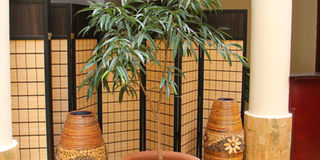Get the best out of your indoor plants

To have healthy indoor plants, you need to get the right type of soil and check for the behaviour of the sun around the location of your plant. If sun rays can sometimes get to it, at the window sill, then look for a plant that can tolerate partial shade and partial sun-rays. Photo by Ismail Kezala
If you want to plant indoors, you have to look for shade plants, according to Joseph Kaka who sells flowers along Mukwano Road in Nsambya:
“First get vases that suit your house. This will depend on the size of your pocket. You can choose ceramic, plastic or clay ones. The ceramic ones are the most expensive.”
Type of soil
You have to get the right type of soil for indoor plants. Kaka explains that it has to be mixed. The proportions will depend on the plants you have chosen.
“Some plants require soil that can keep them wet, while others require soil that can drain quickly. Inquire from the nursery attendant about the soil mixture the plant you have chosen requires.
If possible, let the attendant do it for you, so that you ensure that the plant will tolerate both the container and the soil mixture,” he explains.
The florist adds that in addition to the soil mixture, mix compost as well.
“The proportion of compost to the soil mixture will also depend on the type of plant – whether it requires compost or not.”
Place your soil mixture and compost in layers. Consider what portion has to be laid first and which one last and in what proportions. This is technical. If you mix it all together, it may not grow the plant the right way.For example it may not let water drain quickly, yet the plant you may have chosen may require this, so that the roots remain dry.
Soil preparations
You may need sand, top soil and clay soil. Put stones first at the bottom of your container to help the drainage holes stay open. Then place your sand second, then top soil and compost last, before placing your plant.
Planting
Dig a hole in your soil at this point and place your plant in it. Then get more soil – a mixture of half sand, half top soil. If the plant requires clay and compost, get four equal portions of sand, top soil, clay and compost and fill it on top of the other layers.
If you want to decorate, get some stones and plants to mulch on top of the soil. Look for the right location for your plant. Allocation matters a lot. If you don’t find a good location for that plant, it will die.
Where to place it
Place it where air circulation is good, where it can receive light and where it will not be disturbed. Keep it away from children and pets. It should also be a spot you can easily reach – to inspect it for fungi and other diseases.
If you want to place it in the kitchen, make sure you put it away from all activity – on the window sill, for example. There it can get enough light and air circulation; and children cannot easily get to it.The only problem would be the heat. Heat disturbs plants a lot if the house is not well ventilated.
Whenever you see a plant coiling, changing colour or its compost drying quickly – those are all signs of inadequate air circulation and heat in the house.




